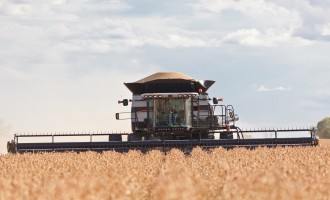HESSTON, Kan. — Drought-stricken soybeans and corn present a number of challenges at harvest. Grain with very low moisture content is difficult to keep clean and intact. However, a few simple combine adjustments can help to prevent grain damage and loss.
John Keller, product performance manager for Gleaner combines, said combine settings may need to be modified to deal with the drought-related harvesting conditions of 2012.Soybeans
Short soybeans are especially difficult to feed into the header and through the combine.
“The way you feed the combine is going to be the biggest factor impacting grain quality, and it always is,” said Keller. “There are some simple tricks to keep in mind to prevent excessive damage to soybeans, especially w ahen pods are brittle and prone to shattering.” He offers this advice: Cylinder speed should be set slower than normal, and it’s critical under drought conditions that the concave is level to the cylinder to prevent brittle beans from splitting.Speeds
Cylinder speeds typically set at 700 RPM should be lowered to 400 RPM. Keep an eye on the concave condition, especially in older combines (seven to 10 years). Slightly reduce airflow in the cleaning shoe, but be careful not to drastically decrease air — too much or too little air will lead to beans bouncing out.
Drought conditions mean plant materials are lighter and more brittle, which will lead to more stems and pods on the shoe; and instead of crop material coming out the end of the rotor, they will come over the shoe — requiring airflow to be monitored closely. Chaffer and sieve screen gaps should be narrowed to maintain air speed, while allowing for enough airflow to remove the pods and other plant material from BB-size beans.Clearance
With less clearance room, settings such as threshing units, cylinder-concave and rotor-grates should also be adjusted accordingly. When plants are lower to the ground, smaller clearances may also be needed between the reel, cutter bar, auger and the feed conveyor chain, to make sure stalks are feeding through the platform.
Keeping the cutter bar low is essential in drought years, when plant populations are low and more pods are close to the ground. Ensure the sickle is sharp — dull sickles will tend to push stems over rather than cut them cleanly. The front drum of the feeder should be low enough so that the chain just clears the floor of the feeder house.Corn harvest
Keller said drought-stressed corn kernels will be smaller and more difficult to keep clean and intact, particularly in many of today’s larger combines.
He offers these three key points: Allow for adequate material flow. In drought years, it’s critical to keep enough material coming into the combine.Lower your header
Lower the header in order to take in more crop material than you normally would. The stalks and leaves will provide cushioning and prevent excessive kernel damage.
Cushioning
Particularly in today’s Bt corn, leaves will hang on to the stalks to help cushion the grain and decrease butt shelling before crop enters feeder house.
You could also use a larger corn head to feed in more rows of crop or increasing the machine’s ground speed.Combine adjustments
If you experience grain damage or combine plugging, this is likely caused by an uneven flow of crop material caused by an improper adjustment.
Refer to the combine operator’s manual or contact your local dealer for advice on combine adjustments for drought conditions. Be careful when threshing to prevent grain from going out the back of the machine. Fan speed should be slowed and sieve openings should be made smaller to account for smaller kernels. Remember to keep the stripper plates close and to narrow the snapping roll openings on your corn head to accommodate smaller ears and stalks.










